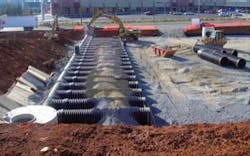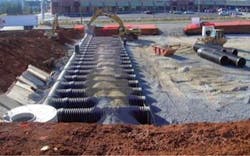Winery Benefits from Green Reclamation Technology
Conn Creek is a small Napa Valley, California, winery that produces Bordeaux-style wines. In 2000 the winery built a 550,000 gallon pond to collect its production wastewater. This water is reclaimed and used to either irrigate the 3.2 acres around the winery or dispersed into a nearby leach field.
Scott Jacobsen, the Maintenance, Safety, and Environmental Specialist at Conn Creek, has overseen the winery’s environmental compliance since 2006. When Jacobsen joined the winery he discovered that the pond was out of compliance with Napa County environmental guidelines. Specifically, the pond’s total suspended solids (TSS) and biological oxygen demand (BOD) were both too high for drip irrigation. This was a problem because the pond provides a significant portion of the vineyard’s water needs.
At that time an outside company was operating the pond and testing water samples for Conn Creek. Jacobsen said the winery was paying a lot of money for the service but the pond was still constantly out of compliance. Additionally, the pond had odor issues that were problematic due to its proximity to the tasting room.
Conn Creek’s 550,000 gallon pond is used to collect all of the winery’s production waste water. This water is reclaimed and services the 3.2 acres around the winery. The photos show the pond before and after the ClearBlu Environmental System was installed. Before is above.
Despite a $75,000 dredging operation, during which five feet of sludge was removed from the bottom of the pond, Jacobsen was still not able to obtain necessary results.
In early 2009 he attended the annual Unified Wine & Grape Symposium in Sacramento. While at the trade show he learned about ClearBlu Environmental, whose booth had a bubble generator working in an aquarium. Jacobsen decided to try the alternative offered by ClearBlu, which proposed to change the pond from a facultative system to an aerobic management system by implementing more effective aeration.
The previous pond management company had been getting oxygen to the top two to three feet of the pond, but left the remaining bottom portion of the pond as an anaerobic environment.
“Most ponds are aerobic only a few feet deep before they turn anaerobic,” said Robert Bixby, one of ClearBlu Environmental’s founders.
ClearBlu uses aeration technology combined with a microbial treatment to create a 100-percent aerobic pond, from top to bottom. Bixby said the aeration technology used in the system is relatively new and had not been employed in California until his company started its work.
The fully aerobic pond is accomplished by using aerators that are able to scale down the bubbles to approximately two-hundredths of a millimeter (or 20 microns) in size, which is much smaller than the two millimeter size that is more common in conventional technology. When the bubbles generated from the aerator are introduced into the pond, a concentration gradient is produced and thus disperses them evenly throughout the water.
Bixby said the system’s aerators operate at about 30 percent of the energy cost of conventional aeration. They are so effective that utility energy rebates are available throughout California.
Because the bubbles are so small, they cannot overcome the surface tension of the water. This allows them to stay submerged much longer than a larger bubble. While the bubbles are capable of remaining in the water for approximately 10 minutes, the effective liquid dissolved oxygen (LDO) can remain for four to six hours. This creates a constant aerobic environment on top of the sludge, which is eaten away by a specific type of microbe that ClearBlu Environmental uses for the task.
The aeration efficiency coupled with the aerobic microbes allows for a more effective process.
“We can treat the wastewater more quickly, plus we don’t build up sludge on the bottom of the ponds,” Bixby said.
The three original aerators in Conn Creek’s pond were removed and replaced with five of the micro bubble surface aerators, reducing the horsepower in the pond from 13 to 9.
In the year and a half that passed between Conn Creek having their pond dredged and hiring ClearBlu Environmental, another foot and a half of sludge had amassed at the bottom. However, the microbes that ClearBlu uses proved to be effective at eating through the sludge.
Jacobsen said that on a daily basis he could see the combination of the new microbes and different aeration technology working in the pond. He remembers seeing little globules of sludge come to the surface where they would float for a few days before “the bacteria finished them off.”
Within four months of hiring ClearBlu the pond was back within the county compliance guidelines and they were able to drop down from five aerators to just three.
When the system was installed in March 2009 the effluent TSS was at 146 mg/L and just one month later it had fallen to 28 mg/L. After another two months it was down to 20 mg/L. This technology is consistently effective, with the numbers recorded at a TSS of 35 mg/L, and a BOD of 19 mg/L in February 2010, one year after installation. The LDO was recorded at 9 mg/L that February.
In addition to regaining compliance, within four months of installation the sludge level was reduced by six inches, and by November 2009 the total sludge depth was just four inches. Bixby said the pond now has a very soft, dark liquid on the bottom of the pond with no sludge.
Overall, Jacobsen is pleased with the ClearBlu system. Changing the pond to all aerobic is “really significant,” he said, explaining that it cleared up the BOD throughout the pond. Along with staying within county regulations, Conn Creek has eliminated the need for a pond management company to dredge the pond.


